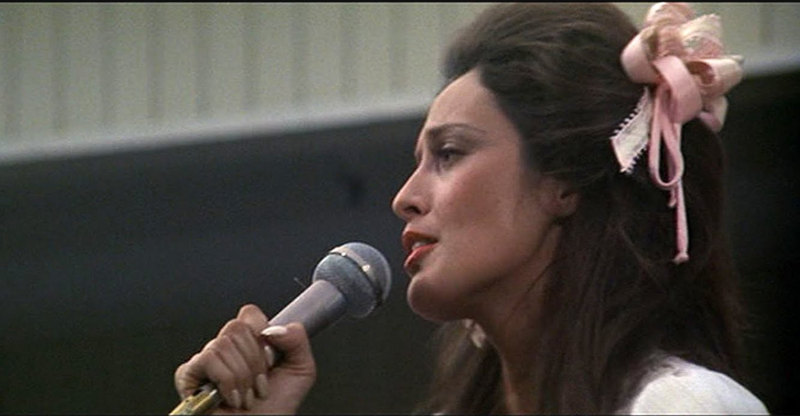When I think of Zorro, I think of Guy Williams in the popular Disney TV series, or I think of Antonio Banderas in two more recent films. I do not think of Alain Delon (“Rocco and His Brothers,” “Le Samouraï,” “Le cercle rouge”), who put on the mask in 1975 to make a film version that’s best described as Spaghetti Westerns meet the “Butch Cassidy and the Sundance Kid” soundtrack and the Keystone Cops.
This indie action-adventure is directed by Duccio Tessari and shot in Spain, as were so many Spaghetti Westerns. And really, how much you like this “Zorro” will depend upon how big of a fan you are of the Italian take on the Old West—or period films shot in the Seventies’ that have unmistakable “era markers,” like the bowl-cut dry-look hair for men, or the peppy, almost ridiculously cheery music that seems incongruous to the action. Sergeant Garcia is here (played by Moustache), though he spends most of his time falling down, like a silent-screen comedian. Some of the scenes go well beyond the kind of incredible antics of earlier tongue-in-cheek swashbucklers. In fact, one of them—a log-whacking forest encounter—will remind some viewers of the Ewoks.
Those are the disclaimers. Once you get past them, the screenplay and the direction are surprisingly good. For one thing, the film offers a nice take on the origin of Zorro, with Don Diego (Delon) playing a nobleman on his way back home to California but stopping first to see an old friend, Miguel de la Serna (Marino Masé). Miguel himself is en route to Nuova Aragon, where he is to take up his newly appointed position as Governor. But New World hotels are just as treacherous as Old World road houses, and the opposition sends assassins to kill Miguel. Before he dies, he makes his friend promise to impersonate him and claim the governorship and do by proxy what Miguel had set out to accomplish: to bring justice and fairness to a region where those in authority abused their power . . . and the people they were supposed to serve.
Then, like almost every other Zorro we’ve seen, this Don Diego pretends to be an effete intellectual aristocrat with no interests beyond his own. As Miguel, he verbally duels with Colonel Huerta (Stanley Baker, who appears here in his last film), the military leader whose men routinely abused the peasants, just as Zorro physically duels with him.
In this version, Diego also has a faithful mute servant (Enzo Cerusico as Joaquín) who pretends not to be able to hear, as well, but he gets considerably more involved as a sidekick than in other films and television shows. Providing the romantic interest is the Contessina Ortensia Pulido (Ottavia Piccolo), whom the Colonel is determined to marry. She, however, has a thing for Zorro, and much in common with Miguel/Don Diego, as she can see right through the pretensions, excesses and cruelties of the ruling class and sympathizes with the people.
The action itself is nicely choreographed and filmed, especially a lengthy swordfight between Zorro and Huerta, whose battle will call to mind old Errol Flynn and Basil Rathbone duels.
Video:
We’re told that Somerville House digitally restored “Zorro,” but the problem in converting to digital is that grain is often read as noise and can pose real problems for film restorers. They got the noise mostly under control, but “Zorro” is still one of the grainiest catalog titles I’ve seen. It may have been digitally restored, but the source master was obviously rough. Some scenes are a little soft-looking as well, though the colors mostly survive the decades since the film was made. Flecks and flickers still occasionally pop up as well, so I’m guessing that “Zorro” had a good number of imperfections, and a comparison bonus features shows that it was definitely improved. Detail is noticeable mostly on the edges, which are crisper than the DVD. It’s presented in 1.85:1 aspect ratio, transferred to a 25GB disc using an AVC/MPEG-4 codec.
Audio:
The audio is a dubbed English DTS-HD MA 2.0, and there are no other audio options or subtitles. It’s as no-frills as it gets. Aside from the obvious limitations of a 2.0 soundtrack, the dialogue is at least clear and distortion-free, but with the swordfight especially you’ll find yourself wishing that the rear speakers could get into the act.
Extras:
Those who are disappointed with the film quality can look at three one-minute clips that illustrate before and after comparisons to show that there WAS progress made. The only other bonus features are two trailers, a radio spot, a photo gallery, and two text-only biographies: one of Delon, the other of director Tessari.
Bottom line:
It’s goofy and it smacks of B-movie dynamics, but Duccio Tessari’s “Zorro” is still an entertaining film.


